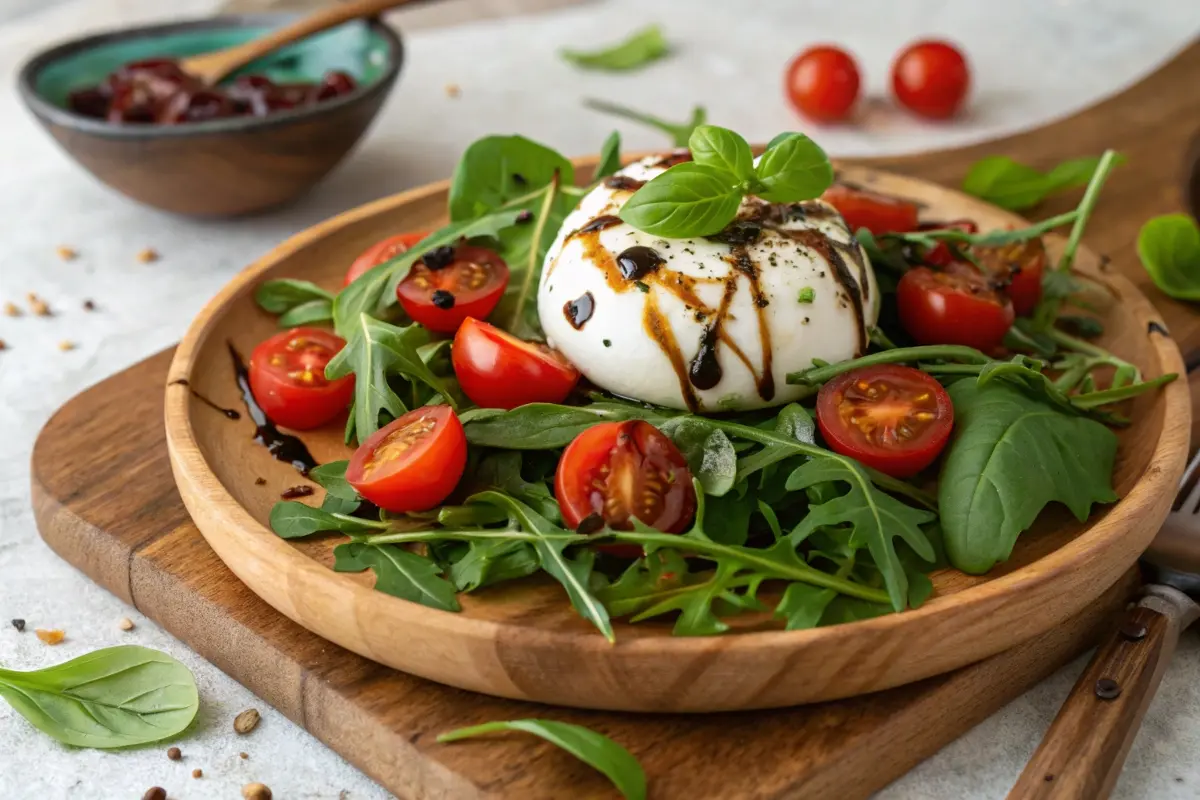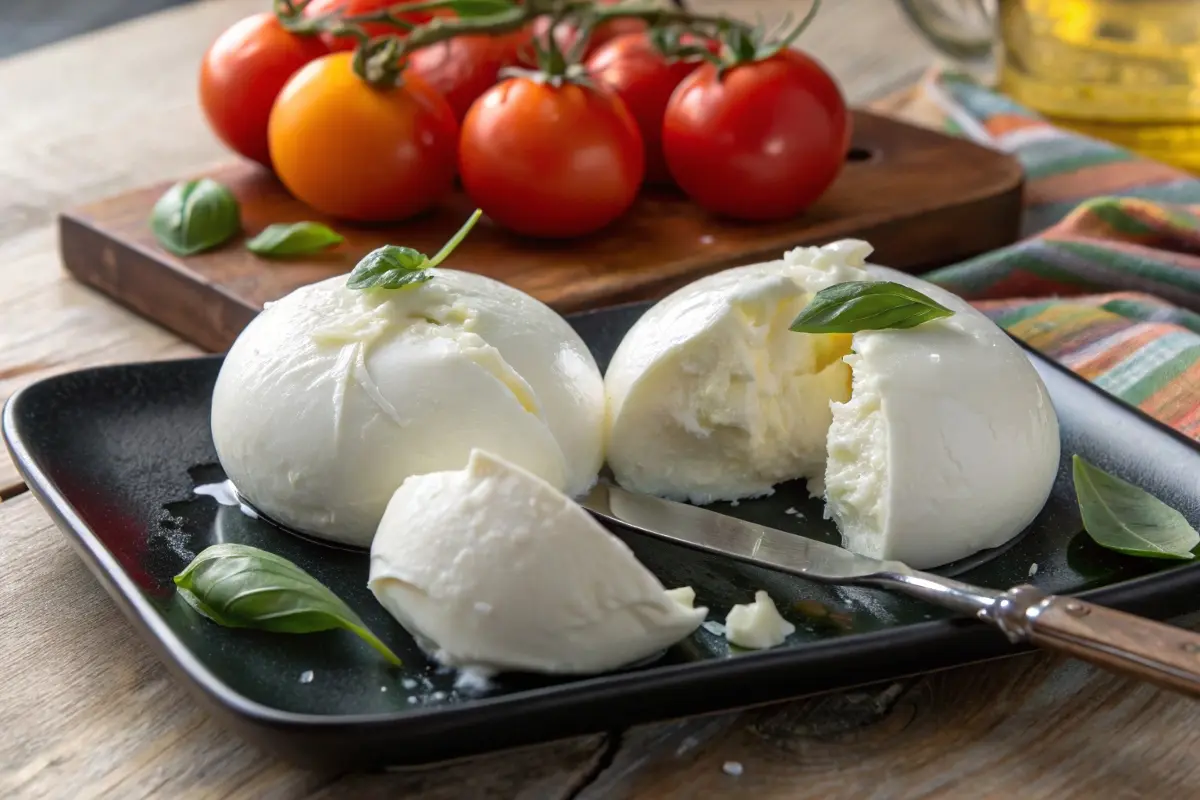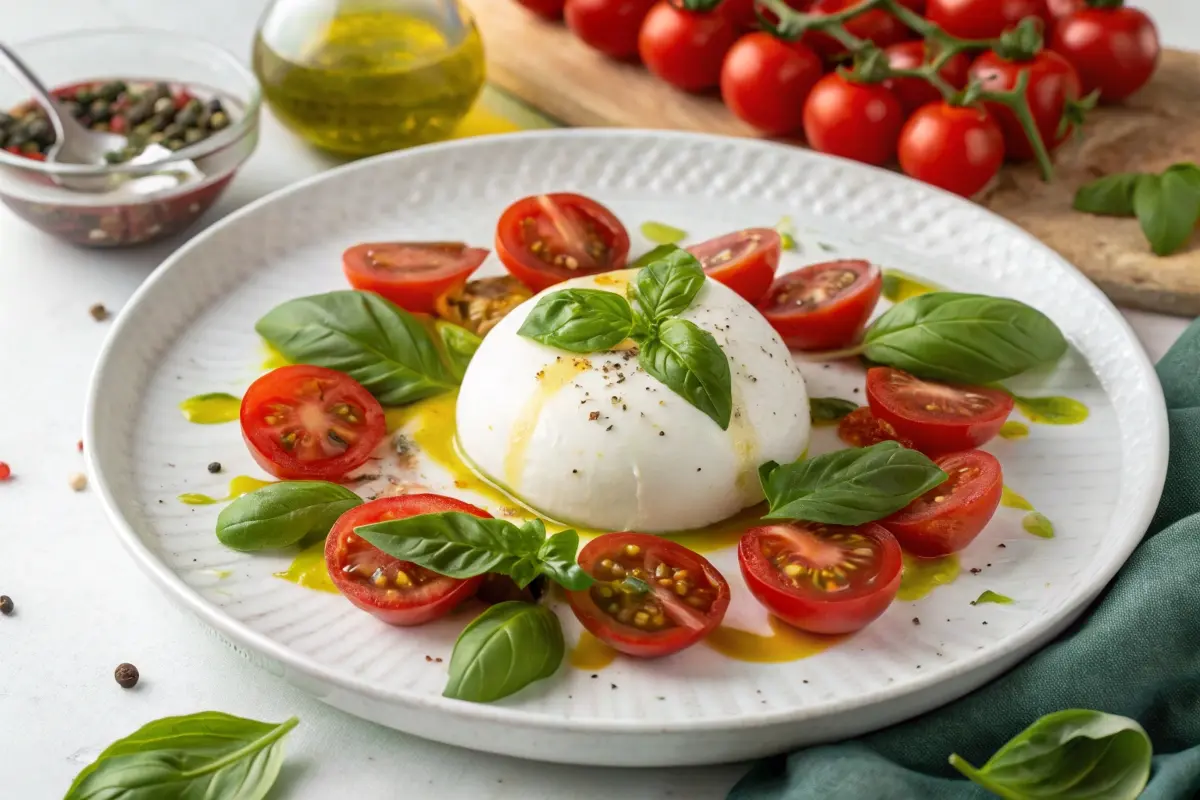Ever wondered why burrata, the creamy and indulgent cheese, comes with a hefty price tag? 🧀 If you’re a cheese lover, you’ve probably been tempted by its rich, creamy texture, only to wonder, “Why does it cost so much?” Let’s explore the factors behind its price and what makes it worth every penny.

What Is Burrata?
A Taste of Luxury
Burrata isn’t your average cheese. This Italian delicacy combines mozzarella’s firm exterior with a luscious, creamy interior made of shredded mozzarella and cream, known as stracciatella. Its unique texture and flavor make it a favorite among cheese connoisseurs worldwide. ✨
“Burrata is the epitome of indulgence, turning simple meals into gourmet experiences.”
A Brief History of Burrata
Burrata’s roots trace back to Puglia, a picturesque region in southern Italy. It was born out of necessity, as cheesemakers sought creative ways to use leftover mozzarella scraps. By stuffing the scraps into a pouch of fresh mozzarella and adding cream, they created Italian fresh cheese—a perfect blend of resourcefulness and luxury.
The Unique Production Process of Burrata
Handmade Craftsmanship
Burrata is not mass-produced like most cheeses. Each piece is carefully handcrafted by skilled artisans who dedicate time and precision to create the perfect consistency. The process demands patience and expertise, making Italian fresh cheese a true labor of love.
The Role of Fresh Ingredients
Freshness is key to burrata’s exceptional taste. High-quality milk from pasture-raised cows or buffalo is essential, as it directly impacts the cheese’s flavor and texture. No shortcuts here—only the best milk will do.
Short Shelf Life and Perishability
Burrata is a ticking time bomb of deliciousness. Its short shelf life, often less than 48 hours, makes it highly perishable. Transporting and storing such a delicate product requires special care, which naturally adds to its cost.
“The fresher the burrata, the better the experience. Anything less than fresh is like a flat soda—disappointing.”
Factors That Drive Burrata’s High Cost
Premium Quality Milk Sources
Cheesemakers rely on premium milk from small-scale farms, where animals are often pasture-raised and well cared for. These farms produce limited quantities of high-quality milk, which increases the production cost of Italian fresh cheese.
Labor-Intensive Production
The handmade nature of burrata production is a significant cost driver. From stretching the mozzarella to forming the creamy filling, every step requires skill and time. Automation is not an option for such a delicate cheese.
Limited Geographic Availability
Authentic Italian fresh cheese is still predominantly made in Italy, particularly in Puglia. Exporting it to other countries involves significant logistical challenges, including refrigerated shipping, which adds to its price.
Import Costs and Tariffs
Burrata doesn’t just travel—it travels carefully. Specialized refrigeration and import tariffs on dairy products further elevate its price when sold outside of Europe.
Comparing Burrata to Other Cheeses
Burrata vs. Mozzarella: Key Differences
At first glance, burrata and mozzarella may look alike, but they couldn’t be more different. While mozzarella is firm and mild, Italian fresh cheese surprises you with its creamy, decadent center. Think of mozzarella as a dependable friend, while Italian fresh cheese is the glamorous guest at a dinner party. 🥂
Why Burrata Is Considered a Luxury Cheese
Burrata’s price reflects its craftsmanship, quality ingredients, and exclusivity. Unlike other cheeses, it’s not something you’ll find on every supermarket shelf, adding to its allure.
The Rising Demand for Burrata
Popularity in Gourmet Cuisine
Burrata has become a star ingredient in high-end restaurants and gourmet recipes. Its creamy center and fresh flavor make it a favorite among chefs looking to elevate their dishes.
Social Media Influence on Burrata Trends
From Instagram posts to TikTok recipe videos, Italian fresh cheese has captured the attention of food lovers worldwide. Its dramatic “cheese pull” and photogenic appearance have made it a social media sensation. 📸

Common Issues With Burrata Pricing
Why Does Burrata Vary in Price by Region?
If you’ve ever compared the cost of burrata across different stores or regions, you’ve likely noticed significant price variations. Why? The answer lies in a combination of factors: transportation, local demand, and the availability of fresh ingredients.
For example, in regions closer to artisanal cheese producers, Italian fresh cheese may be more affordable due to lower shipping costs. However, in areas far from dairy farms, the need for refrigerated transportation and middlemen drastically raises the price. Additionally, some stores market Italian fresh cheese as a “luxury item,” inflating its cost to appeal to high-end shoppers.
Can Burrata Be Affordable Without Compromising Quality?
The dream of enjoying burrata without emptying your wallet is possible, but it comes with compromises. Some producers cut corners by using lower-quality milk or skipping steps in the traditional crafting process. While this makes Italian fresh cheese more affordable, it often results in a product that lacks the creamy, fresh texture and rich flavor that make the cheese so beloved.
Solutions to Make Burrata More Accessible
Supporting Local Artisanal Producers
One way to enjoy high-quality burrata without paying exorbitant prices is to buy directly from local cheesemakers. Supporting local businesses not only reduces costs by cutting out the middleman but also helps sustain traditional cheesemaking practices. Many small-scale farms sell fresh Italian fresh cheese at farmers’ markets or specialty food shops.
Exploring Homemade Burrata Recipes
Feeling adventurous? Making burrata at home can be a rewarding experience. While it requires time and practice, homemade Italian fresh cheese allows you to control the quality of ingredients and significantly reduces costs. All you need is fresh milk, rennet, and a few basic tools.
Here’s a simple recipe to get you started:
Homemade Burrata Recipe
Ingredients:
- 1 gallon of fresh cow or buffalo milk
- 1 teaspoon of rennet
- 1/2 cup of heavy cream
- 1 teaspoon of salt
Preparation Method:
- Heat the milk to 90°F in a large pot, stirring gently.
- Add rennet and let the mixture sit for 10 minutes until it begins to curdle.
- Cut the curds into small pieces and gently heat again to 105°F while stirring.
- Strain the curds and shape them into a mozzarella shell.
- Mix shredded mozzarella with cream to create the filling and seal it inside the shell.
- Serve fresh and enjoy your homemade burrata! 🧀
“Nothing tastes better than cheese you made with your own hands!”
Tips for Enjoying Burrata Without Breaking the Bank
Affordable Pairings and Recipes
Burrata shines when paired with simple, budget-friendly ingredients. Here are a few affordable pairing ideas that maximize flavor without overspending:
- Fresh Tomatoes: Slice up ripe, juicy tomatoes and drizzle them with olive oil, salt, and pepper. Add burrata for a delicious caprese salad twist.
- Pasta: Toss cooked pasta with olive oil, garlic, and roasted vegetables, then top it with Italian fresh cheese for a creamy finish.
- Crusty Bread: Serve Italian fresh cheese with toasted slices of sourdough or baguette and a sprinkle of sea salt for an easy appetizer.
These recipes are proof that Italian fresh cheese can transform simple meals into gourmet experiences. 😋
Storing Burrata to Maximize Freshness
Burrata is best enjoyed fresh, but proper storage can help extend its shelf life by a day or two. Here are some tips:
- Keep burrata submerged in its original liquid until ready to serve.
- Store it in the coldest part of your refrigerator.
- Avoid freezing Italian fresh cheese , as it ruins the cheese’s texture.
“Think of burrata like a bouquet of flowers—it’s best enjoyed fresh, but proper care can prolong its beauty.”
The Rising Demand for Burrata
Burrata in Everyday Cooking
What was once a niche gourmet item is now finding its way into everyday kitchens. Home cooks are increasingly experimenting with Italian fresh cheese in salads, pizzas, and even desserts. Its versatility and rich texture make it a popular choice for elevating simple dishes.
Social Media’s Role in Burrata’s Popularity
Platforms like Instagram and TikTok have given burrata a cult following. Videos of Italian fresh cheese “explosions,” where the creamy center spills out dramatically, have gone viral, turning this cheese into a visual sensation. Food influencers often highlight burrata’s luxurious appeal, further boosting its demand.
Nutrition Facts About Burrata
For those who love burrata but are conscious of their diet, here’s a quick breakdown of its nutritional profile:
| Nutrient | Per 100g |
|---|---|
| Calories | 300 kcal |
| Protein | 14g |
| Fat | 25g |
| Carbohydrates | 1g |
| Calcium | 150mg |
| Sodium | 150mg |
While Italian fresh cheese is rich in fat and calories, it also provides a good amount of protein and calcium. Moderation is key to enjoying it as part of a balanced diet. 🥗
The Global Appeal of Burrata
Burrata Around the World
Though Italian fresh cheese has its roots in Italy, its appeal has spread far and wide. Today, Italian fresh cheese is cherished by food enthusiasts in North America, Europe, Asia, and beyond. Countries like the United States and Japan have seen a surge in demand as consumers increasingly seek out gourmet and artisanal products.
What makes Italian fresh cheese so universally loved? It’s the perfect balance of simplicity and luxury. Whether served on a rustic Italian platter or a high-end restaurant plate in New York City, Italian fresh cheese finds its way into every cuisine.
Creative Burrata Recipes Across Cultures
Chefs worldwide are putting their own spin on Italian fresh cheese. Here are some unique dishes that showcase burrata’s versatility:
- Japanese Burrata Sushi Rolls: Fusion cuisine at its best—Italian fresh cheese paired with sushi rice and fresh tuna.
- Indian Burrata Curry: Creamy Italian fresh cheese added to a rich tomato-based curry for a decadent twist.
- Mexican Burrata Tacos: Used as a topping for tacos with roasted peppers and fresh cilantro.
These international adaptations highlight how Italian fresh cheesetranscends cultural boundaries, making it a true global icon.
Burrata’s Role in Sustainable Eating
Supporting Small-Scale Cheesemakers
Burrata production often comes from small, family-owned farms that prioritize animal welfare and sustainable practices. By purchasing authentic Italian fresh cheese, you’re not just indulging in high-quality cheese—you’re also supporting a system that values ethical farming and sustainability.
Reducing Food Waste
Did you know that Italian fresh cheese was originally invented to reduce food waste? Cheesemakers used leftover mozzarella scraps to create the creamy filling. By celebrating Italian fresh cheese, we’re honoring a tradition of resourcefulness and sustainability. 🌍
Homemade Burrata and Sustainable Living
Making Italian fresh cheese at home is another way to embrace sustainable living. By sourcing local milk and making small batches, you can reduce your carbon footprint while enjoying fresh, high-quality cheese.
Tips for Incorporating Burrata Into Your Diet
Pairing Burrata with Healthy Ingredients
While burrata is rich and indulgent, it can be part of a balanced diet when paired with nutrient-rich ingredients. Try these combinations:
- Burrata and Arugula Salad: Add fresh arugula, cherry tomatoes, and a drizzle of lemon vinaigrette for a light, refreshing dish.
- Whole-Grain Burrata Toast: Spread Italian fresh cheese on whole-grain bread and top with avocado and a sprinkle of chili flakes.
- Vegetable Burrata Bowl: Roast seasonal vegetables and serve them over quinoa with Italian fresh cheese for a satisfying meal.
Enjoying Burrata in Moderation
Due to its high fat and calorie content, Italian fresh cheese is best enjoyed in moderation. Treat it as a special addition to your meals rather than an everyday staple.

Frequently Asked Questions About Burrata
How Should Burrata Be Served?
Burrata is best served at room temperature. Allow it to sit outside the fridge for 30 minutes before enjoying it. This enhances its creamy texture and flavor. Pair it with:
- Fresh bread
- Olive oil and balsamic glaze
- Seasonal fruits like figs or peaches
Is Burrata Gluten-Free?
Yes, Italian fresh cheese is naturally gluten-free, making it a safe and delicious choice for those with gluten sensitivities or celiac disease.
How Do You Know If Burrata Is Fresh?
Fresh Italian fresh cheese should have a shiny, smooth exterior and a creamy, slightly liquid center. If the outer layer feels dry or the inside is too firm, it’s likely past its prime.
Is Burrata the Same as Mozzarella?
No, burrata is not the same as mozzarella, but they are closely related. Italian fresh cheese has a mozzarella exterior, but its creamy, rich interior is filled with stracciatella and cream, making it much softer and more indulgent than traditional mozzarella. Think of Italian fresh cheese as mozzarella’s luxurious cousin!
Is Burrata Halal?
Whether Italian fresh cheese is halal depends on how it’s made. Traditional Italian fresh cheese may use animal-derived rennet, which might not be halal. However, some cheesemakers use microbial or vegetarian rennet, making the cheese suitable for those following a halal diet. Always check the label or confirm with the producer.
Do You Eat the Skin on Burrata?
Yes, you can and should eat the skin of Italian fresh cheese! The outer layer is made of mozzarella, giving it a firmer texture that complements the creamy filling inside. Together, they create the perfect balance of textures and flavors.
Why is burrata so expensive?
Understanding the Value Behind Burrata’s Price
Burrata’s high cost is a reflection of its premium quality, labor-intensive production, and perishable nature. Every bite of Italian fresh cheese is a celebration of tradition, craftsmanship, and fresh ingredients—a combination that justifies its luxurious status.
Balancing Quality, Cost, and Enjoyment
While burrata may not be an everyday indulgence for most, it’s worth treating yourself to this creamy delight once in a while. By supporting local producers or trying your hand at homemade Italian fresh cheese, you can enjoy this cheese without breaking the bank.
“Burrata is not just food; it’s an experience worth savoring.”
